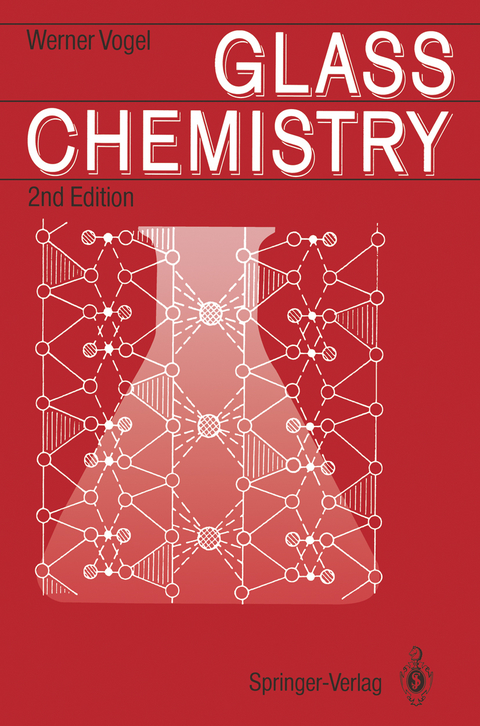
Glass Chemistry
Springer Berlin (Verlag)
978-3-642-78725-6 (ISBN)
Glass Chemistry is an interdisciplinary book on the borderlines between chemistry, physics, mineralogy and even biology and medicine. The book represents a well balanced treatment for students, scientists and engineers.
GLass Chemistry is an interdisciplinary book on the borderlines between chemistry, physics, mineralogy and even biology and medicine. The book represents a well balanced treatment for students, scientists and engineers. The central themes of the book are the chemistry and the physics of a large number of glasses for various applications.
1 Historical Development of Glass Chemistry.- 1.1 The Beginnings of Glass Research.- 1.2 History of the Chemistry of Optical Glass.- 1.3 History of Technical Glass.- 2 Freezing of a Melt to a Vitreous Solid.- 2.1 Fusion and Crystallization. General.- 2.2 Significant Differences Between Crystalline and Non-crystalline (Glassy) Solids.- 2.3 Standard Viscosity Temperatures for Solidification of Glasses.- 2.4 Annealing of Optical Glass.- 3 Structural Elements of Silicates.- 3.1 The SiO4 Tetrahedron as the Basic Building Block of Silicates.- 3.2 Building Units of Natural Crystalline Silicates.- 4 Classical Theories of Glass Structure.- 4.1 Glass Structure According to Tammann (since 1903).- 4.2 Glass Formation According to Goldschmidt.- 4.3 The Zachariasen-Warren Network Theory.- 4.4 Extension of the Network Theory by Dietzel.- 4.5 Additional Concepts Supplementing the Network Theory.- 4.6 Lebedev's Crystallite Theory.- 4.7 Further Development of the Crystallite Theory.- 4.8 Kinetic Theory.- 5 Methodology in Glass Research.- 5.1 Structure of Liquids and Melts.- 5.2 The Nuclear Magnetic Resonance Method as Applied to Glass Research.- 5.3 Electron Microscopy.- 6 Microphase Separation.- 6.1 Early History.- 6.2 Electron Microscopy Evidence for Immiscibility Phenomena in Glasses.- 6.3 Theoretical Treatment.- 6.4 Experimental Evidence.- 7 Structure and Properties of Colorless Glasses.- 7.1 Silica Glass.- 7.2 Alkali Silicate Glasses.- 7.3 Alkaline Earth and Alkali-Alkaline Earth Silicate Glasses.- 7.4 Borate and Borosilicate Glasses.- 7.5 Glasses of High Lead Content.- 7.6 Phosphate Glasses.- 7.7 Tellurite Glasses.- 7.8 Beryllium Fluoride Glasses - "Model Glasses".- 7.9 Zirconium Fluoride Glasses.- 7.10 Germanate Glasses.- 7.11 Glasses Containing Arsenic Oxide.- 7.12Glasses Containing Antimony Oxide.- 7.13 Glasses Containing Bismuth Oxide.- 7.14 Limited Glass Formation in Systems of Exclusively Scientific Interest.- 7.15 Metal Glasses.- 7.16 Vitreous Carbon.- 7.17 The Sol-Gel Method for Production of Glasses and Glass Ceramics.- 8 New Optical High-Performance Glasses.- 8.1 Fundamental Principles of the Dispersion Behaviour of Glasses.- 8.2 Change of the Dispersion with the Introduction of Additional Absorption Centers.- 8.3 Optical Glasses with Unusual Partial Dispersions.- 8.4 Athermal Optical Glasses.- 8.5 Non-linear Refraction.- 8.6 Prerequisites on the Raw Material for the Production of Optical Glasses.- 9 Structure and Properties of Colored Glasses.- 9.1 General.- 9.2 Absorption of Colorless Base Glasses.- 9.3 Glasses Colored by Ions.- 9.4 Striking Glasses.- 9.5 Glasses Colored by Metal Colloids (Ruby Glasses).- 9.6 IR-Absorbing Glasses (Heat-Absorbing Glasses).- 9.7 IR-Transmitting Glasses.- 9.8 Opacified Glasses.- 10 Crystallization of Glasses.- 10.1 General.- 10.2 Theoretical Considerations.- 10.3 Crystallization as a Defect in Glass.- 10.4 Controlled Crystallization.- 10.5 Bioactive, Piezoelectric, Phosphate Glass Ceramics Free of Silica.- 10.6 Sintered and Special Glass Ceramics.- 11 The Strength of Glass.- 11.1 Theoretical Strength.- 11.2 Effective Strength: Attempts at Theoretical and Practical Explanations.- 11.3 Strengthening Methods in Practice.- 12 Interaction Between High Energy Radiation and Glass.- 12.1 General Considerations.- 12.2 Photosensitive Glasses Based on the Formation of Metal Colloids.- 12.3 Photosensitive Glasses Based on Partial Crystallization in Lithium and Barium Silicate Systems.- 12.4 Dosimeter Glasses.- 12.5 Photochromic Systems and Glasses.- 12.6 Laser Glasses.- 12.7 Radiation Protection andRadiation-Resistant ("Protected") Glasses.- 12.8 Transmission Changes of Colored Glasses under ? Irradiation.- 12.9 Solarization.- 13 Survey of the Physical Basis of Some Glass Properties.- 13.1 Introduction.- 13.2 Refraction of Light, Dispersion and Abbe's Value.- 13.3 Density.- 13.4 Molar Refraction.- 13.5 Thermal Expansion.- 13.6 Viscosity.- 13.7 Strain.- 13.8 Surface Tension.- 13.9 Heat Conductivity, Specific Heat.- 13.10 Electrical Conductivity.- References.
| Erscheint lt. Verlag | 22.11.2011 |
|---|---|
| Übersetzer | N. Kreidl, M. Lopes Barreto |
| Zusatzinfo | XIV, 464 p. |
| Verlagsort | Berlin |
| Sprache | englisch |
| Maße | 155 x 235 mm |
| Gewicht | 726 g |
| Themenwelt | Naturwissenschaften ► Chemie ► Anorganische Chemie |
| Naturwissenschaften ► Chemie ► Technische Chemie | |
| Naturwissenschaften ► Geowissenschaften ► Mineralogie / Paläontologie | |
| Schlagworte | Ceramics • Crystal • Glas • Glass • Materials Science • Mineralogy • Na2O • Network Theory • Nonmetallic Materials • SiO2 • Sol-Gel • thermodynamics |
| ISBN-10 | 3-642-78725-8 / 3642787258 |
| ISBN-13 | 978-3-642-78725-6 / 9783642787256 |
| Zustand | Neuware |
| Haben Sie eine Frage zum Produkt? |
aus dem Bereich


